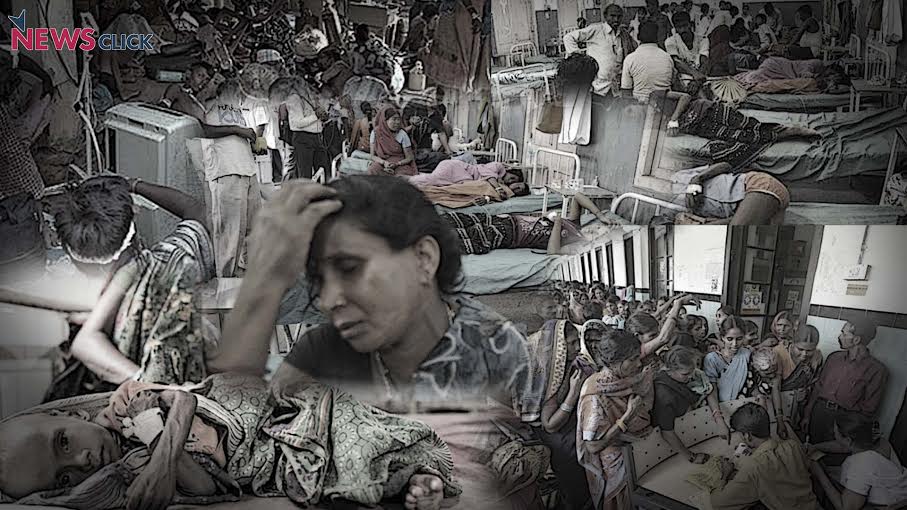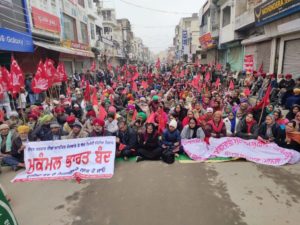Bharat Dogra
Over the last two years, the most common comment on allocations for the health sector in the union budgets was that there has been “some increase” in it. However, any headline that really captures the wider reality would have said that the ‘government has fallen behind health commitments by over Rs 30,000 crore and made big cuts in priorities’.
Keeping the extremely low allocations for the health sector in India in mind, the National Health Policy 2017 fixed a target of raising central and state allocations to 2.5% of GDP by 2025. This should be taken as a minimum, as according to comparisons with several other countries and India’s own needs, the allocation should actually be higher than this target.
Since this limited target cannot be achieved in one go, the National Health Mission prepared a road-map so that by gradual increases in state and union health budgets year-on-year, the stipulated target can be achieved by 2025.
As per this road map, the Union government allocation in 2019-20 should have been Rs 1 lakh crore, but the actual allocation fell short by around Rs 34,000 crore. In 2020-21 the allocation should have been Rs 1.24 lakh crore, but actual allocation fell short by about Rs 55,000 crore.
Coming to the second part of the proposed headline, about making budget cuts in its own priority schemes, the Union government has in recent times been most vociferous about its Ayushmann Bharat scheme, also known as Pradhan Mantri Jan Arogya Yojana (PMJAY). The original allocation for the scheme in the 2019-20 budget was Rs 6,400 crore but this was cut to half, or Rs 3,200 crore, in the Revised Estimate (RE). This year, the budget allocation is back to Rs 6,400 crore.
However, in the case of this and other insurance-driven schemes, the primary issue is not the budget cut but how these schemes are gradually driving India towards a system driven by insurance companies and private health providers instead of concentrating more attention and resources on public health.
The biggest model of such private-profit and insurance-driven health systems is in the United States. Dr Sandeep Jauhar has worked at senior positions within the American system and has been writing about it in The New York Times. In his book, titled Doctored—The Disillusionment of an American Physician, he quotes a congressional investigation which found that surgeons had performed 2.4 million unnecessary operations resulting in 12,000 deaths.
The Institute of Medicine has estimated that wasteful health spending (spending that does not improve health outcomes) costs $750 billion annually in the US. A study published in the New England Journal of Medicine found that one in five Medicare patients discharged from hospitals was re-admitted within a month. In a survey of 12,000 physicians in the US, only 6% said that morale was positive and that depression levels among physicians have been high.
Among all professions in the US, the suicide rate is highest among physicians. “We allowed insurance companies to come between us and our patients,” a doctor lamented.
A rich country like the US may be able to manage the wastes and frauds of such a system, but not a poor country like India which needs a strong public health system but is staring at a serious shortage of funds. A glaring indicator is the official data for 2018, which records that there is an 82% shortage of specialist doctors in Community Health Centers (CHCs), which primarily treat rural patients. Among the states, Uttar Pradesh has a 94% shortage.
A large number of rural health centers lack the most basic facilities. Horror stories of people, particularly children, dying due to lack of proper care even after reaching big public hospitals continue to be reported from time to time.
The need to spend more on private health care has emerged as a leading cause of people being pushed into poverty.
In a country like India, preventive health care and social medicine is probably one of the most important factors in improving health outcomes. However, this will be relegated to the background once the country embarks on a private sector, profit and insurance driven health model. In a recent review of health sector budgets, the Centre for Budget and Governance Accountability has noted, “A continuous effort on the part of the Union Government to shift from healthcare provisioning to purchasing has been observed in recent years. National Health Policy 2017 coined the term Strategic Purchasing to describe a gradual conversion of the government’s role from a provider to a purchaser of healthcare services for its citizens.”
Another point raised in this review is a special concern for economically-weaker states in the context of performance-based component of central funds. The review notes that 14 states were penalised in 2018-19. “Most of these are economically weaker states with poor infrastructure and human development indicators. Penalties imposed on such states, in terms of loss of resources from the Centre, might adversely affect the underprivileged sections in these states as they depend on public provisioning for health.”
Meanwhile, the health sector allocation of the budget as a percentage of GDP has remained more or less stagnant at around 0.3% during the last four years. To be more exact, the actual expenditure in 2017-18 was 0.32% of GDP and the 2020-21 budget estimate for this is 0.31%. So, there is actually a decline, whereas the road map outlined by the Modi Government to increase health spending to 2.5% of the GDP calls for a gradual increase in Centre’s health spending.
As a proportion of the total Union Budget, the health spending was 2.6% in 2017-18; in the 2020-21 BE, this is down to 2.3%. Overall, there is certainly a clear trend of the Union Government going back on its critical health commitments, as expressed in its own policy statements. This is not good news at all for our health.
(The writer is a freelance journalist who has been involved with several social movements.)



